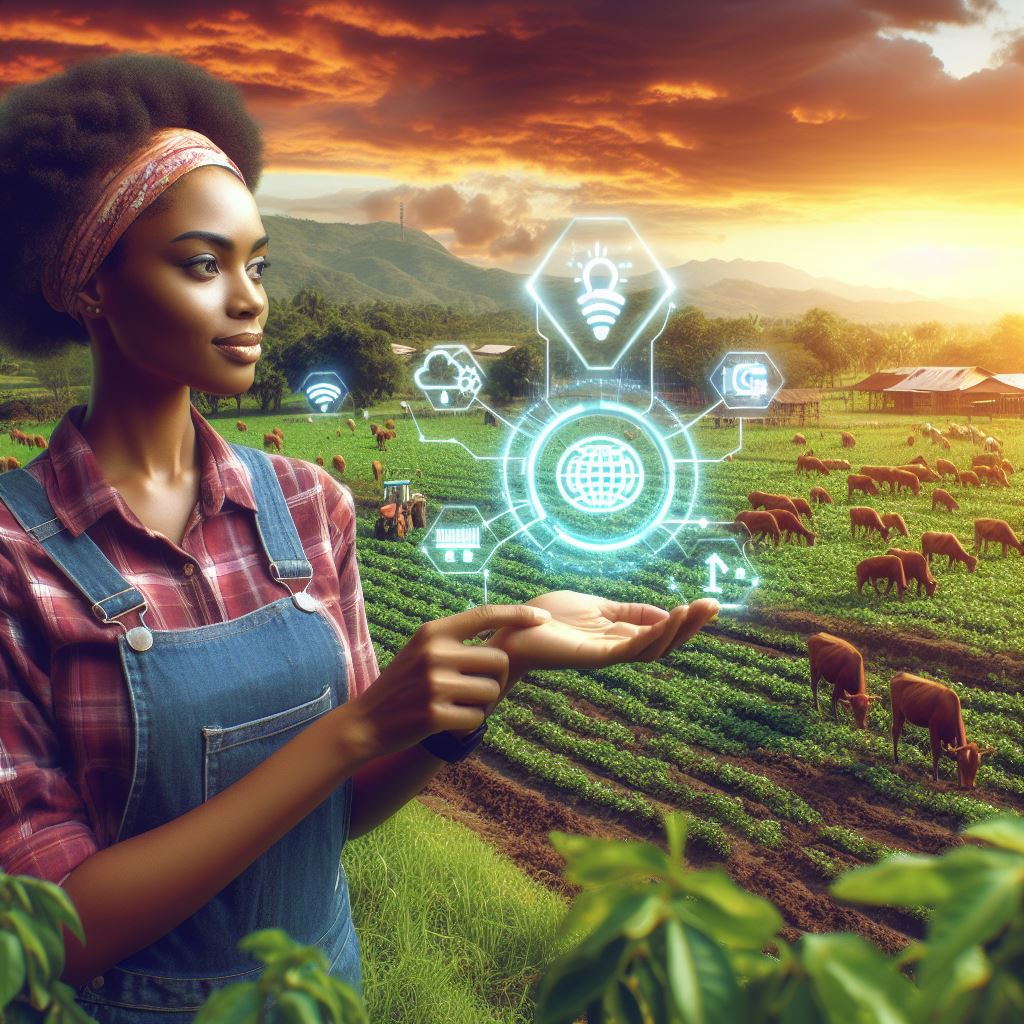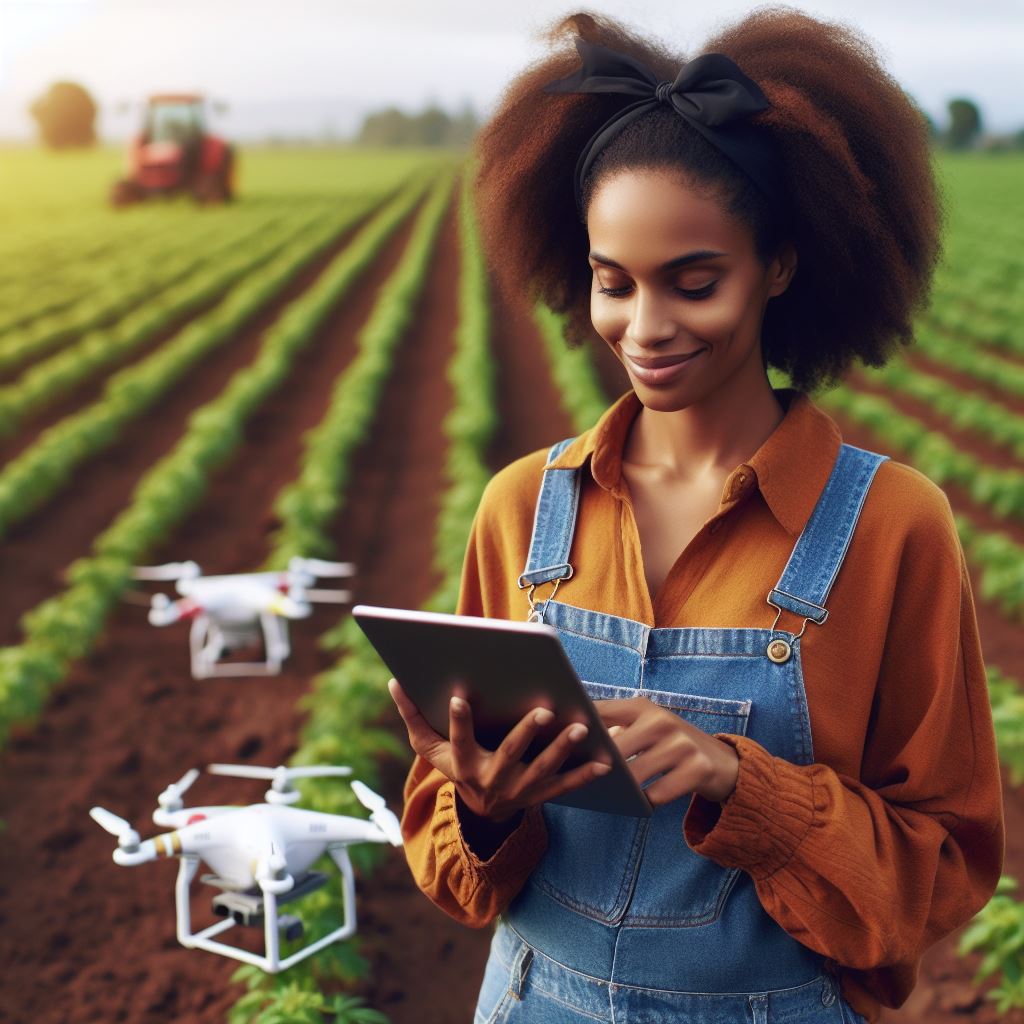Introduction
Definition of Agri IoT
Agri IoT, or Agricultural Internet of Things, refers to the use of internet-connected devices in agriculture to enhance production and efficiency.
Importance of connectivity in the fight against climate change
Connectivity plays a crucial role in combating climate change by enabling real-time monitoring, data analysis, and precision farming.
In recent years, agriculture has faced numerous challenges due to climate change.
Rising temperatures, changing precipitation patterns, and extreme weather events are impacting crop yields and livestock productivity.
The need to adapt and mitigate these effects has become more urgent than ever.
Agri IoT offers promising solutions by leveraging connectivity and data-driven technologies.
By connecting devices such as sensors, drones, and smart irrigation systems, farmers can gather real-time data on weather conditions, soil moisture levels, and crop health.
This data forms the foundation for informed decision-making and proactive management.
For instance, connected sensors can monitor temperature and humidity levels in a greenhouse, allowing farmers to ensure ideal growth conditions for their crops.
Automated irrigation systems can adjust water usage based on real-time soil moisture readings, optimizing resource usage and reducing water waste.
Additionally, connectivity enables the integration of data from multiple sources, allowing farmers to leverage advanced analytics and artificial intelligence algorithms.
These technologies can analyze large datasets to provide insights on pest infestations, disease outbreaks, and yield predictions.
With such information, farmers can implement targeted interventions, minimizing losses and optimizing productivity.
The power of connectivity lies in its ability to facilitate collaboration and knowledge sharing among farmers, researchers, and agricultural experts.
Through connected platforms and networks, best practices can be shared, and innovative solutions can be developed and deployed on a larger scale.
In fact, Agri IoT and connectivity have emerged as critical tools in the fight against climate change.
By harnessing the power of data and connected devices, agriculture can become more resilient, sustainable, and efficient.
With the right investments and policies, we can leverage the potential of Agri IoT to secure our food systems for a changing climate.
Advantages of Agri IoT in Climate Fight
In recent years, the agricultural industry has been facing numerous challenges due to changing climate patterns.
Extreme weather events, water scarcity, and unpredictable pest infestations have highlighted the need for innovative solutions.
Agri IoT, with its potential to revolutionize farming practices, has emerged as a vital tool in the fight against climate change.
Improved crop management and resource utilization
- Remote monitoring of environmental conditions: With Agri IoT, farmers can remotely monitor essential environmental factors such as temperature, humidity, soil moisture, and light intensity. Real-time data helps them analyze and understand crop requirements accurately.
- Precision irrigation and fertilization: By integrating IoT-driven sensors and actuators, farmers can precisely control the irrigation and fertilization process. This technology enables tailored watering and nutrient delivery based on specific crop needs, optimizing resource usage.
- Early pest detection and control: Agri IoT offers advanced pest monitoring systems that leverage machine learning and data analytics to detect pest presence in crops at an early stage. Farmers can take preventive measures promptly and minimize the use of harmful chemical pesticides.
Enhancing sustainability and reducing environmental impact
- Optimized water and energy consumption: IoT-connected devices enable the collection and analysis of data related to water usage, allowing farmers to optimize irrigation. By applying the right amount of water at the right time, water wastage can be reduced significantly. Similarly, energy consumption for irrigation pumps can be optimized.
- Reduction in chemical inputs: Through IoT-enabled monitoring systems, farmers can accurately determine the nutrient requirements of crops. This leads to efficient fertilizer usage, reducing the reliance on chemical fertilizers. Consequently, soil health improves, and environmental pollution decreases.
- Minimization of food waste: The implementation of IoT technology in the entire supply chain enables real-time tracking of perishable goods. Farmers, distributors, and retailers can monitor and manage inventory effectively. This helps to reduce food waste, contributing to a more sustainable food system.
Agri IoT provides immense potential for transforming agriculture into a more climate-resilient and sustainable sector.
By leveraging the advantages of remote monitoring, precision management, and data-driven decision-making, farmers can adapt to climate challenges and mitigate their environmental impact.
Embracing Agri IoT is crucial for a future where agriculture harmonizes with nature and contributes to combatting climate change.
Read: Urban Farms: Answer to Climate?
Connectivity Challenges in Agriculture
Connectivity is crucial in harnessing the full potential of Agri IoT, but there are several challenges that need to be addressed in order to ensure its effective implementation.
Limited internet access in rural areas
One of the primary obstacles faced in deploying Agri IoT is the limited internet access available in rural areas.
Many farming communities lack access to reliable and high-speed internet connections, hindering the seamless transmission of data between devices and platforms.
This issue can be attributed to the lack of infrastructure development in remote areas.
Internet service providers often prioritize urban regions, leaving farmers in rural areas with limited connectivity options.
Connectivity issues in remote agricultural fields
In addition to limited internet access, remote agricultural fields present further connectivity challenges.
These fields are often located in areas with weak or no network coverage, making it difficult for IoT devices to communicate with each other and relay data to farmers.
Transform Your Agribusiness
Unlock your farm's potential with expert advice tailored to your needs. Get actionable steps that drive real results.
Get StartedThe distance between remote fields and network towers amplifies signal loss, leading to unreliable connections.
This connectivity issue not only hampers data transmission but also affects real-time monitoring and control of agricultural systems.
High costs and infrastructure requirements
Implementing Agri IoT involves significant financial investment, including the cost of acquiring and deploying IoT devices, sensors, and gateways.
Moreover, the installation of necessary infrastructure, such as network towers and internet connectivity, adds to the overall expenses.
For farmers with limited resources, these high costs and infrastructure requirements pose significant barriers to adopting Agri IoT technologies.
Without proper financial support and assistance, agricultural connectivity remains out of reach for many farmers.
Data security and privacy concerns
As agriculture becomes more connected, concerns regarding data security and privacy are on the rise.
With interconnected devices and systems, there is an increased vulnerability to cyber threats and data breaches.
Farmers and agricultural organizations must ensure that robust security measures are in place to protect sensitive data.
The secure transmission and storage of data, as well as stringent access controls, are essential to maintain the privacy and integrity of agricultural information.
Regulatory frameworks and industry standards need to be established to address these concerns and build trust among farmers, stakeholders, and consumers.
Efforts must be made to educate farmers about the importance of data security and privacy, and to provide them with the necessary tools and knowledge to protect their data effectively.
In general, connectivity plays a vital role in the successful implementation of Agri IoT.
However, challenges such as limited internet access, connectivity issues in remote areas, high costs, and data security concerns need to be overcome to ensure widespread adoption of these technologies.
Collaborative efforts from governments, Internet service providers, and agricultural organizations are necessary to bridge the connectivity gap and enable farmers to fully leverage the benefits of Agri IoT in their fight against climate change.
Read: Storms & Soil Erosion: Safeguarding US Farmlands

Emerging Technologies in Agri IoT Connectivity
Satellite and Aerial Connectivity Solutions
The use of satellite and aerial connectivity solutions has revolutionized the agricultural industry.
These technologies provide farmers with real-time data on weather conditions, crop health, and soil moisture levels.
Satellite connectivity allows farmers to access information from remote areas without the need for physical infrastructure.
It enables the collection of data from large areas and provides a global coverage, ensuring that farmers have access to accurate and up-to-date information.
Aerial connectivity, on the other hand, involves the use of drones equipped with sensors and cameras.
These drones can capture high-resolution images of crops and identify any signs of disease or nutrient deficiencies.
The data collected by these drones is then transmitted to farmers, allowing them to take immediate action.
LPWAN Technologies (LoRaWAN, Sigfox, NB-IoT)
LPWAN technologies, such as LoRaWAN, Sigfox, and NB-IoT, are specifically designed for long-range communication with low-power consumption.
These technologies are ideal for agricultural applications as they can cover large areas with minimal infrastructure requirements.
LoRaWAN is a wireless communication protocol that enables connectivity for IoT devices over long distances.
It allows farmers to monitor and control agricultural assets remotely, such as irrigation systems and weather stations.
Sigfox is another LPWAN technology that operates on unlicensed spectrum, providing low-cost and low-power connectivity for IoT devices.
It is particularly useful for monitoring soil moisture, temperature, and humidity levels in agricultural fields.
NB-IoT, or Narrowband IoT, is a cellular wireless technology that offers low-power, wide-area connectivity.
It enables farmers to track livestock, monitor equipment usage, and manage crop irrigation efficiently.
High-Altitude Platforms (HAPs) and Drones
High-altitude platforms (HAPs) and drones play a crucial role in Agri IoT connectivity by extending the coverage area and providing real-time data.
HAPs are solar-powered platforms placed in the stratosphere, offering a cost-effective alternative to satellite connectivity.
Drones equipped with sensors and cameras can collect data on crop health, pest infestations, and drought conditions.
This information is transmitted to farmers, allowing them to make informed decisions regarding crop management and resource allocation.
Both HAPs and drones provide farmers with a cost-effective solution for monitoring agricultural operations on a large scale.
They enable the collection of data in real-time, improving efficiency and maximizing crop yield.
Mesh Networks and Wireless Sensors
Mesh networks and wireless sensors are integral to Agri IoT connectivity as they enable the seamless transmission of data in a networked environment.
Consisting of multiple nodes, mesh networks communicate with each other to exchange information.
Wireless sensors, on the other hand, are small devices that measure various parameters such as temperature, humidity, and soil moisture.
These sensors collect data and transmit it to a gateway device, which then sends the information to farmers.
Mesh networks and wireless sensors are highly scalable and can be easily deployed in agricultural settings.
They provide reliable and continuous data transmission, allowing farmers to monitor environmental conditions and optimize crop production.
In a nutshell, the emergence of various technologies in Agri IoT connectivity has transformed the agricultural industry.
Satellite and aerial connectivity solutions, LPWAN technologies, high-altitude platforms, and mesh networks with wireless sensors enable farmers to make data-driven decisions, improve efficiency, and mitigate the effects of climate change.
Read: Protecting Crops from Extreme Rainfall
Explore Further: How Climate Change Is Affecting Your Food Supply
Showcase Your Farming Business
Publish your professional farming services profile on our blog for a one-time fee of $200 and reach a dedicated audience of farmers and agribusiness owners.
Publish Your ProfileCase Studies on Agri IoT Implementation
In this section, we will explore case studies of agri IoT implementation in different parts of the world.
These examples demonstrate how IoT is being leveraged to boost productivity, efficiency, and sustainability in agriculture.
Smart agriculture projects in developed countries
- In the USA, vineyards are utilizing IoT sensors to enhance their agricultural practices. These sensors monitor crucial factors such as soil moisture and temperature, helping farmers make informed decisions about irrigation and pest control. Real-time data from the sensors enable farmers to optimize water usage, reduce costs, and lower environmental impact. The collected data can also be used to improve future crop yields and quality.
- The Netherlands is at the forefront of precision agriculture in greenhouses. By implementing IoT technologies, greenhouse owners can maintain optimal conditions for plant growth. Sensors measure variables like temperature, humidity, light intensity, and carbon dioxide levels. This information is then analyzed to automate irrigation, adjust climate control, and optimize the use of resources. IoT-driven precision agriculture boosts crop yield, improves quality, and reduces reliance on chemical treatments, making it a sustainable approach.
Agri IoT initiatives in developing countries
- In India, where agriculture plays a vital role in the economy, IoT has been instrumental in addressing water scarcity. IoT-based irrigation systems are being deployed in rural areas to optimize water usage. Farmers can remotely monitor soil moisture levels and receive alerts about irrigation requirements. By ensuring accurate and timely irrigation, IoT helps in conserving water and maximizing crop yield. This technology has the potential to uplift rural farming communities while conserving precious resources.
- Kenya, with its significant agricultural sector, has embraced IoT for remote monitoring of livestock and soil conditions. Livestock farmers can track the health and location of their animals using IoT-enabled wearable devices. This allows for prompt intervention in case of any illness or emergency. Additionally, soil sensors provide real-time data about moisture, pH levels, and nutrient content, enabling farmers to make data-driven decisions regarding fertilizers and soil management. IoT-driven monitoring helps in reducing losses, preventing diseases, and maximizing productivity.
These case studies illustrate the transformative impact of agri IoT worldwide, whether it’s in developed countries with advanced farming techniques or in developing nations facing challenges such as water scarcity and remote farming conditions.
By harnessing the power of IoT, agriculture is becoming more sustainable, productive, and resilient.
Agri IoT has the potential to revolutionize the global food system by increasing yields, minimizing resource wastage, and mitigating the effects of climate change.
As technology continues to evolve, we can expect further advancements in agri IoT adoption and implementation, enabling farmers to overcome challenges and contribute to a more sustainable future.
Read: Permaculture: Climate Change Shield
Policy Implications and Future Prospects
Government support and investment in Agri IoT
With the aforementioned policy implications and future prospects in mind, Agri IoT can revolutionize the agricultural industry globally.
Governments should prioritize supporting and investing in this technology.
International collaboration in developing IoT standards
International collaboration is crucial in establishing standardized protocols for Agri IoT devices, enabling seamless integration across different regions.
By doing so, the benefits and advancements of Agri IoT can be shared worldwide.
Potential for scaling up Agri IoT globally
Furthermore, the potential for scaling up Agri IoT globally is immense.
It has the power to overcome various agricultural challenges, such as resource inefficiency, crop diseases, and food security.
Government bodies and organizations need to recognize this potential and allocate resources to facilitate its widespread adoption.
Integration with other emerging technologies (AI, machine learning)
Moreover, the integration of Agri IoT with other emerging technologies, such as artificial intelligence (AI) and machine learning, can unlock new possibilities.
AI algorithms can analyze the vast amount of data collected by Agri IoT devices, providing actionable insights for farmers.
Machine learning algorithms can continuously improve agricultural practices by learning from real-time data and optimizing resource allocation.
In short, Agri IoT holds tremendous promise in transforming the agricultural sector.
Government support and investment are crucial to drive its advancements.
International collaboration is necessary to establish standardized IoT protocols, facilitating global connectivity.
Scaling up Agri IoT globally will require concerted efforts and strategic planning.
Integration with other emerging technologies like AI and machine learning can further enhance its capabilities.
With the right policies and collaborative approach, Agri IoT can pave the way for a sustainable and productive future in agriculture.
Gain More Insights: Crops vs. Climate: Diversity for Stability
Conclusion
Recap of Agri IoT benefits in the climate fight
Agri IoT and its connectivity have tremendous benefits in the battle against climate change.
By enabling real-time monitoring, data analysis, and automation, Agri IoT revolutionizes the agricultural industry.
It improves resource efficiency, reduces waste, optimizes crop yields, and promotes sustainable farming practices.
Call to action for embracing Agri IoT and connectivity in agriculture
It is crucial for stakeholders in the agricultural sector to embrace Agri IoT and connectivity.
Investing in advanced technology and infrastructure will lead to a more resilient and sustainable industry.
By collaborating and implementing Agri IoT systems, we can make significant progress in mitigating climate change.
Overall optimism about the potential impact of Agri IoT in combating climate change
Despite the challenges, there is great optimism about the potential impact of Agri IoT in combating climate change.
With the power of data-driven decision-making, predictive analytics, and smart agricultural practices.
We can transform the agricultural landscape, adapt to climate variability, and secure food production for future generations.
Agri IoT is not just a technological innovation; it is a powerful tool for the sustainability of our planet.
Let us prioritize connectivity, embrace Agri IoT, and work together towards a greener and more resilient future.




